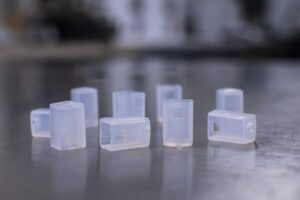 Stratasys and Extrusion Tips
Stratasys and Extrusion Tips
CNC machined custom parts will only get you so far – especially when producing larger quantities results in higher costs. This is exactly the situation where Stratasys, a global leader in 3D printing and production systems for direct digital manufacturing, found themselves.
But first, a bit of background on Stratasys. The innovative 3D printing equipment they create allows engineers and technologists the world over to develop new products, tools and production parts in a fraction of the time originally required.
One of the most critical 3D printing components is the extrusion tip. It’s a stylus-shaped object that directs molten plastic to parts as they’re being constructed during the printing process.
To protect this somewhat fragile extrusion tip, a tip shield is installed over it. For the tip shield to perform well, it must be made of a heat resistant material and have release properties that allow plastics to break away cleanly from its surface.
Stratasys engineers initially picked PTFE (polytetrafluoroethylene) as the tip shield material. But because PTFE couldn’t be molded into the required shape, the parts were instead produced using CNC machining.
Tip shields, however, are replaced frequently due to high wear and tear – and CNC machining large quantities of these parts proved expensive. This is what led Stratasys engineers to contact Savillex in hopes of finding a more cost-effective, injection molded solution.
PFA Injection Molding Provides More Cost-Effective Consumable Parts
Savillex engineers reviewed the tip shield design requirements with Stratasys and proposed using a injection molded PFA part. Further testing by Stratasys confirmed that PFA would indeed meet their requirements.
One immediate obstacle was that the tip shield’s current design was not suitable for a PFA injection molded part; wall sections had to be thickened and fillets added. Savillex engineers worked with Stratasys to optimize the part design for PFA injection molding.
Once the design was finalized, several processing scenarios were analyzed to meet targeted costs. Savillex tool designers then determined that a stand-alone, four-cavity tool would be needed, and fine-tuned the tool design to account for the tip shield’s tight tolerances (+/- .001 inches.)
In the end, Savillex used their expertise in PFA injection molding to provide Stratasys with high volumes of fully functional tip shields that met their cost reduction targets.
While you’re here reading, be sure to check out another great example of where Savillex Custom Services delivered improved custom tooling for a client.
Need to draw on Savillex expertise to create your own custom parts? Drop us a line and request a quote today.



